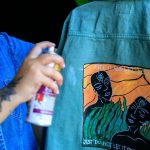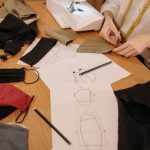Have you ever marveled at the flawless seams of a well-constructed garment and wondered about the secret behind it? Consider this: By hand basting fabric seams before machine stitching, you can achieve impeccable results.
Hand basting, an age-old technique, involves temporarily sewing fabric layers together with large, easily removable stitches. This method allows for precise alignment and prevents shifting during machine stitching, resulting in perfectly matched seams.
In this guide, we will explore the history, advantages, step-by-step technique, and expert insights on hand basting, as well as compare it to machine stitching.
Mastering the art of hand basting could be the key to elevating your sewing projects to the next level.
Key Takeaways
- Hand basting allows for precise fitting adjustments and the construction of complex garments.
- It offers the opportunity for traditional craftsmanship and precise seam creation.
- Hand basting enhances accuracy and ensures impeccably tailored garments.
- Hand basting is particularly beneficial when working with delicate fabrics, aligning pattern pieces, or achieving smooth gathers or pleats.
The History of Hand Baste Stitch
The history of hand baste stitch dates back to the early 17th century, when tailors and seamstresses utilized this technique for securing fabric temporarily during garment construction. This traditional technique involved using long, easily removable stitches to hold fabric layers together before final machine stitching. Over time, hand baste stitch has played a pivotal role in the stitching evolution, as it allowed for precise fitting adjustments and facilitated the construction of complex garments.
The traditional techniques of hand baste stitch have stood the test of time and remain an essential skill in garment construction. Its significance lies in the ability to ensure accurate fitting and proper drape of the fabric before the final stitching. As stitching evolved, the hand baste stitch continued to be a fundamental practice, especially in bespoke tailoring and couture garment construction.
Understanding the history and evolution of hand baste stitch provides valuable insight into the foundations of garment construction. Mastery of this traditional technique not only honors the rich heritage of sewing but also equips the modern seamstress with the expertise to achieve impeccable, professional results.
Advantages of Hand Basting
When hand basting, you gain the advantage of being able to accurately assess the fabric's drape and fit before committing to final machine stitching. This improved accuracy is crucial in achieving perfectly tailored garments.
Hand basting allows you to make adjustments as needed, ensuring that the garment fits flawlessly before permanent stitching. Additionally, hand basting offers the opportunity for traditional craftsmanship, allowing you to take the time to carefully manipulate the fabric and create precise seams. This level of attention to detail is often difficult to achieve with machine stitching alone.
By utilizing hand basting techniques, you're able to control the fabric more effectively, resulting in a finished product that reflects meticulous craftsmanship and attention to detail. Furthermore, hand basting provides the flexibility to easily modify seam lines and make alterations without the commitment of machine stitching.
Ultimately, the advantages of hand basting lie in its ability to enhance accuracy and allow for the application of traditional craftsmanship, leading to impeccably tailored and well-fitted garments.
Step-by-Step Hand Basting Technique
To master the step-by-step hand basting technique, start by selecting a fine needle and thread that matches the fabric. A sharp needle will make it easier to penetrate the fabric without causing unnecessary damage, and a matching thread will ensure that the basting stitches blend seamlessly into the fabric.
Begin by threading the needle and tying a knot at the end of the thread. Then, starting from the wrong side of the fabric, insert the needle and pull it through, leaving a tail of thread at the beginning of the seam. Take small even stitches, about 1/4 inch in length, and space them evenly along the seam line. Ensure that the stitches are loose enough to be easily removed later.
Once you reach the end of the seam, secure the thread with a knot and trim any excess.
This hand basting tutorial provides a foundation for achieving precise and flawless seams. The benefits of hand basting include improved accuracy in matching seams and easing the sewing process, making it an essential skill for achieving professional results.
Hand Basting Vs. Machine Stitching
Considering both hand basting and machine stitching, your sewing project's success will depend on choosing the method that best suits your fabric and desired outcome.
Hand basting, a traditional sewing technique, involves temporarily stitching fabric layers together by hand with a loose, easily removable stitch. This method allows for precise control and adjustment of fabric alignment before final stitching. Hand basting is particularly useful when working with delicate or slippery fabrics, intricate patterns, or when matching plaids or stripes across seams.
On the other hand, machine stitching offers efficiency and strength, ideal for securing most fabric types quickly. It's suitable for straightforward seams, garment construction, and repetitive tasks.
When deciding between hand basting and machine stitching, consider the intricacy of your project, the fabric's characteristics, and the desired level of control. For complex designs or fabrics requiring careful manipulation, hand basting provides the precision needed for perfect fabric seams. However, for simpler projects or when time is a factor, machine stitching may be the more practical choice.
Ultimately, mastering both techniques will equip you to handle various sewing challenges with confidence.
Tips for Effective Hand Basting
Once you've chosen hand basting as your preferred method, ensure that you secure the fabric layers together with even, loose stitches. To achieve the best results, use high-quality thread that contrasts with the fabric for better visibility.
Hand basting offers several benefits, such as increased control and precision, making it an essential skill in professional sewing techniques. When hand basting, start by anchoring the thread within the seam allowance, and then work in long, straight stitches. Keep your stitches evenly spaced, approximately 1/4 inch apart, to maintain consistent tension.
It's important to baste along the grain of the fabric to prevent distortion. When basting complex or curved seams, use shorter stitches to navigate the contours smoothly. Remember to remove the basting stitches once the permanent stitching is complete. This will ensure that the final seam is clean and free from any residual basting thread.
With practice, hand basting will become an invaluable technique in your sewing repertoire, leading to perfectly aligned seams and professional-quality garments.
Expert Insights on Hand Basting
Have you ever wondered about the expert insights on hand basting? When it comes to achieving impeccable fabric seams, professionals have honed their hand basting techniques to perfection. Here are some expert insights to elevate your hand basting skills:
- Precision and Control: Experts emphasize the unparalleled precision and control that hand basting offers. Unlike machine basting, hand basting allows for meticulous placement of stitches, ensuring that fabric layers align perfectly before permanent stitching.
- Hand Basting Alternatives: Professionals often recommend hand basting as the gold standard, but they also acknowledge that certain fabrics or projects may benefit from alternative basting methods. Expert insights explore the use of temporary fabric adhesives or specialty tapes as effective alternatives in specific scenarios.
- Professional Hand Basting Techniques: Seasoned professionals emphasize the importance of mastering various hand basting techniques, such as running stitch, backstitch, or tailor's tack. Understanding when and how to employ these techniques can significantly impact the quality of fabric seams.
In the pursuit of mastering fabric construction, incorporating these expert insights on hand basting can elevate your sewing prowess and result in flawless, professional-grade seams.
Frequently Asked Questions
Can Hand Basting Be Used on All Types of Fabric, or Are There Limitations?
When considering hand basting, it's essential to assess its limitations. Delicate fabrics and intricate designs may benefit from hand basting, but it's important to weigh the advantages against time efficiency for optimal results.
How Long Does It Take to Hand Baste a Typical Garment, and Is It Worth the Extra Time and Effort?
Hand basting can take extra time but offers precise control over fabric alignment and seam accuracy. Pros include improved fitting and easier adjustments. However, it can be time-consuming, especially for larger garments, impacting time management.
Are There Any Common Mistakes to Watch Out for When Hand Basting Fabric Seams?
Avoid common mistakes by using the correct technique for hand basting fabric seams. Improving accuracy and ensuring even tension are crucial. Pay attention to stitch length and spacing, and always remove basting stitches after machine sewing.
Can Hand Basting Be Used for More Complex Garment Construction, Such as Tailored Jackets or Formal Gowns?
When working on intricate garments like tailored jackets or formal gowns, hand basting is a valuable technique. It allows for precision in complex construction, such as intricate embroidery, and is gentle on delicate fabrics.
Are There Any Specific Tools or Materials That Are Essential for Effective Hand Basting, Beyond Just Needle and Thread?
To effectively hand baste, essential tools and materials include a sharp needle, high-quality thread, and fabric-friendly marking tools. Proper hand basting techniques and fabric preparation are also crucial for achieving perfect seams.
- Choosing the Right Fabrics for Babies - July 20, 2024
- Impact of Fabrics on Skin Health - July 20, 2024
- Benefits of Antimicrobial Fabrics - July 20, 2024








